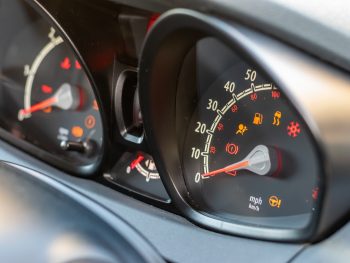Four in 10 drivers ignore dashboard warning signs
More than four in 10 (43%) UK drivers ignore critical dashboard warning signs, putting themselves at risk of breakdowns and costly repairs.

The research found 15% of drivers ignore illuminated warning lights in their car for more than a week
The research, carried out by Green Flag, also found that 15% of drivers ignore illuminated warning lights in their car for more than a week, despite dashboard warning lights playing a critical role in safety and vehicle performance.
A third (31%) of drivers have experienced a breakdown, accident or damaged their car because they ignored a warning light.
Top reasons for drivers ignoring warning lights include not thinking it was urgent (61%), trusting their car would be fine (26%) and thinking repair would be too expensive (18%).
Table 1: Top reasons drivers ignore their dashboard warning lights
| Reasons for ignoring dashboard warning lights | Per cent |
| I didn’t think it was urgent | 61% |
| I trusted my car would be fine | 26% |
| Repairs were too expensive | 18% |
| I didn’t have time to take my car to the garage | 17% |
| I didn’t understand what the light meant | 16% |
| I forgot about it | 10% |
| I didn’t realise it was a warning light | 5% |
Source: Green Flag 2024
But, worryingly, 96% of drivers were not able to accurately identify what all their warning lights are for.
The research also shows a big gap in awareness of individual warning lights.
Despite 60% believing they could confidently identify the brake pad warning light, just over a fifth (22%) could. Three-quarters of drivers (77%) thought they were familiar with the check engine light, but only just over a third (39%) could correctly identify it.
When unsure of the meaning of a light, nearly half (47%) rely on the car manual to correctly identify it, a third (33%) turn to the internet, 13% call a friend or family member and the same number go to the garage (13%).
Concerningly, almost a quarter (23%) of drivers would not take their car to the garage after seeing the battery warning light and more than one tenth (11%) wouldn’t do so after their brake pad light came on – both warnings that could easily result in a breakdown if not addressed.
Table 2: Dashboard warning lights identification and action
| Warning light | Driver said they could confidently identify warning light | Driver accurately identified warning light | Driver wouldn’t take their car to a garage after seeing the warning light |
| Airbag warning 1 | 69% | 63% | 16% |
| Airbag warning 2 | 69% | 76% | 16% |
| Anti-lock braking system (ABS) warning light | 68% | 77% | 12% |
| Brake pad warning light | 60% | 22% | 11% |
| Brake system warning light | 69% | 30% | Nine% |
| Battery warning light | 80% | 88% | 23% |
| Check engine light | 77% | 39% | 14% |
| Electronic stability programme (ESP) system light | 48% | 26% | 13% |
| Engine temperature warning | 78% | 70% | 17% |
| Oil pressure warning | 80% | 83% | 23% |
| Tyre pressure warning | 78% | 39% | 48% |
Source: Green Flag 2024














